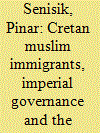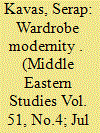|
|
|
Sort Order |
|
|
|
Items / Page
|
|
|
|
|
|
|
| Srl | Item |
| 1 |
ID:
121462


|
|
|
|
|
| Publication |
2013.
|
| Summary/Abstract |
This study is an attempt to shed light on the issue of Cretan Muslim emigration from Crete to the Ottoman Empire in order to analyse the multiple connections among the Ottoman state, immigrants and different localities in the Eastern Mediterranean in the late nineteenth century. Following the Cretan revolts of 1896 and 1897, the establishment of autonomous government on the island of Crete and the withdrawal of Ottoman armies from the island, Cretan Muslims began to emigrate from Crete to various places in the Ottoman Empire. Specifically, this article aims to deal with the migration of Cretan Muslims and to focus mainly on the year 1899, during which large numbers of Muslims were forced to leave their homes. The article suggests that Cretan Muslim emigration provides a good case for understanding the attitudes and policies of the Ottoman state towards migration, and the relationship between the state and immigrants, as well as for analysing the broader connections between Crete and the other localities of the Eastern Mediterranean. The working hypothesis is that in order to understand certain socio-political and demographic changes and transformations experienced within the Ottoman Empire in the late nineteenth century, it is important to study the issue of Cretan Muslim immigration to Ottoman Anatolia. This presents an opportunity to investigate certain questions with regard to the dynamics of migration and also to discuss certain facts associated with migration within the late imperial context.
|
|
|
|
|
|
|
|
|
|
|
|
|
|
|
|
| 2 |
ID:
181289


|
|
|
|
|
| Summary/Abstract |
This study aims to examine the nature and success of Ottoman modernization in the realm of religious practice by studying the central state’s attempts to standardize Friday sermons, or the hutbe. This study claims that the hutbe was a site for the negotiation of local and central power, both separately and in relationship to one another. Changes in the form, content, and medium of the hutbe in the late nineteenth century reveal that the central state was not the only actor that influenced the hutbe. Local populations and power holders, administrators, and clerics played a crucial role in determining the appointment of the preachers and the content of the hutbe, which in practice did not always serve state interests. The hutbe was not always a venue for state propaganda; it was also a venue in which local demands, discontents, and dissatisfactions were expressed in different ways. In other words, the process of standardization of religious practices and beliefs was not a top-down, state-centric development in which local actors were passive receptors. The main purpose of the study is to demonstrate the complexities, contingencies, and mediations in the standardization and centralization policies of the empire throughout the late nineteenth century.
|
|
|
|
|
|
|
|
|
|
|
|
|
|
|
|
| 3 |
ID:
093762


|
|
|
|
|
| Publication |
2010.
|
| Summary/Abstract |
In championing women's rights, Semseddin Sami (1850-1904) sought to remould Ottoman social conscience along an egalitarian ethic based on gender equality in intelligence. In his novel Taassuk-i Talat ve Fitnat, his treatise Women, and his six-volume encyclopaedia Kamus al-A'lam, he offered the ideal of monogamous marriage based on love and forgiveness, underscored the imperative of female education and job opportunities, and demonstrated the wide range of women's achievements throughout Islamic and Western history. The remaking of men needed to complement the remaking of women. Detailed studies of individual writers and magazines are necessary to gain an appreciation of the struggle to redefine the dignity of women in the late Ottoman Empire.
|
|
|
|
|
|
|
|
|
|
|
|
|
|
|
|
| 4 |
ID:
139306


|
|
|
|
|
| Summary/Abstract |
To a social thinker who is used to dealing with macro aspects of sociopolitical phenomena,
the issue of clothing may sound trifling, or at best may be viewed as an insignificant detail of social life and thus be discounted as secondary. However, what are considered mundane issues may themselves be so heavily loaded and may bear such subtle and unique meanings that inattention to them may result in missing some very important insights allowing a much closer analysis of larger issues, such as the experience of modernization, in particular, in a non-western context. As Comaroff and Comaroff rightly put it, ‘Cultural revolutions usually rooted themselves on modest terrain, in simple acts of fabrication, use, exchange. Even the most elaborate social formations arise from such quotidian acts’.
|
|
|
|
|
|
|
|
|
|
|
|
|
|
|
|
|
|
|
|
|